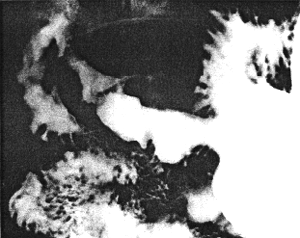



Go to chapter: 1 | 2 | 3 | 4 | 5 | 6 | 7 | 8 | 9 | 10 | 11 | 12 | 13 | 14 | 15 | 16 | 17 | 18 | 19 | 20 | 21 | 22 | 23 | 24 | 25 | 26 | 27 | 28 | 29 | 30 | 31 | 32 | 33 | 34 | 35 | 36 | 37 | 38 | 39
Chapter 27 (page 128)
Having received approval of the Ethical Committee, the test was performed in 100
patients between the ages of l8 and 79 years who, during the ordinary course of events,
had been referred for radiographic examinations because of upper gastro-intestinal
symptoms, e.g. dyspepsia and epigastric pain.
No Lesion Detected
In 48 patients no macroscopic organic lesion could be demonstrated in the upper gastro-
intestinal tract; these were considered to be patients with non-ulcer dyspepsia. Eighteen
(± 37 percent) had minimal to moderate duodenogastric reflux. In all cases reflux
occurred during those stages of the pyloric cycle in which the pyloric sphincteric cylinder
was relaxed (Fig. 27.2), or partially contracted (Fig. 27.3). Reflux never occurred during
maximal contraction of the cylinder.
Duodenal Ulceration
In our series there were 25 cases of active duodenal ulceration or duodenal deformity
typical of ulceration, l8 (approximately 72 percent) showing moderate duodenogastric
reflux.
Gastric Ulceration
We encountered 9 cases of chronic benign ulcer on the lesser curvature of the stomach at
varying distances proximal to the pyloric sphincteric cylinder, i.e. not within the cylinder
itself. Seven of these showed moderate reflux. In the present series no cases of benign
gastric ulceration within the pyloric sphincteric cylinder were seen.
Malignant Gastric Ulceration
In our series 2 cases of malignant gastric ulceration (proved by biopsy) were diagnosed.
In one case, with the ulcer on the lesser curvature close to the pylorus (i.e. within the
sphincteric cylinder), there was moderate to marked reflux. In the second case, with the
ulcer at the incisura angularis, no reflux was seen.
Sliding Hiatus Hernia with Free Gastro-Oesophageal Reflux
There were 9 cases in the present series, 4 showing reflux of duodenal contents into the
stomach.
Combined Lesions
In the present series 7 cases had combined lesions, e.g. duodenal ulceration and hiatus
hernia. Most of these showed reflux. One of these cases had constant spasticity of the
pyloric sphincteric cylinder with irregular and transverse mucosal folds (Fig. 27.4). It
was diagnosed radiologically and endoscopically as spasm and chronic gastritis affecting
the cylinder. In addition the duodenal bulb was deformed due to ulceration. In this case
moderate to marked duodenogastric reflux occurred. Owing to the tube-like spasm of the
cylinder, the pyloric aperture was neither fully open nor fully closed, but fixed in a state
of partial patency.
 |
Fig. 27.4.
Barium filling of spastic pyloric sphincteric cylinder in a case of chronic
gastritis. Duodenal bulb deformed
|
Duodenal Motility
In the last 40 patients of the series, special attention was paid to duodenal motility. In 32
of these the aborad and orad movements of intraluminal barium were identical to those in
normal controls. In 8 no orad movement of contrast was seen in the second and third
parts of the duodenum, yet in half of these cases duodenogastric reflux occurred. One's
impression was that physiological duodenal movements were probably of little
consequence in the mechanism of reflux. (By experimentally reversing the pacesetter
potential in the duodenum in canines by electrical stimulation, Kelly and Code l977 did
produce reflux.)
Pyloric Motility
As in normal control subjects, reflux in patients only occurred while the pyloric
sphincteric cylinder was relaxed or in a state of partial contraction; it never occurred
during maximal contraction of the cylinder.
Previous Page | Table of Contents | Next Page
© Copyright PLiG 1998







